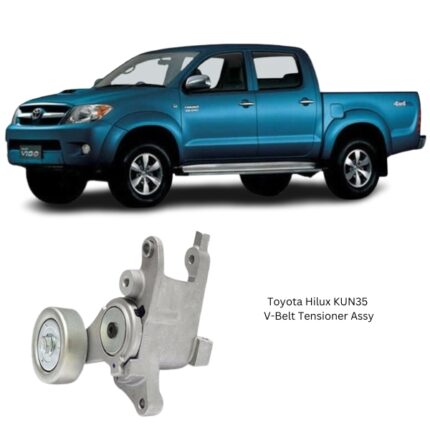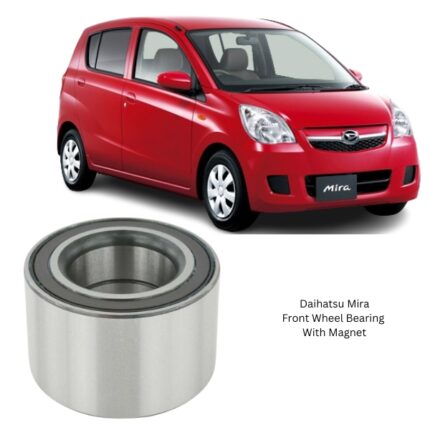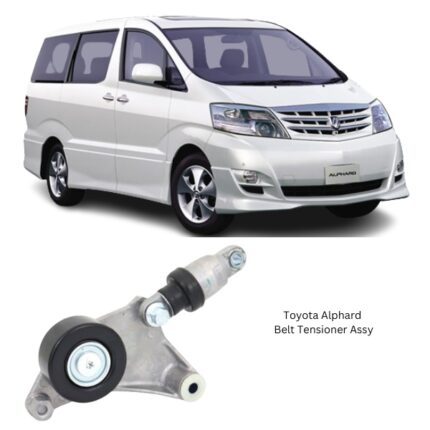-9%
Get Toyota Alphard Belt Tensioner Assy 16620-28011 in Kenya
The Fan Belt Tensioner Assembly is a precision-engineered mechanical component that plays a vital role in the engine accessory drive system. It is designed to automatically maintain proper tension on the serpentine belt (commonly referred to as the fan belt), which is responsible for transmitting rotational energy from the crankshaft to multiple engine accessories. These may include the alternator, power steering pump, air conditioning compressor, and water pump.
Proper tension in the fan belt is essential for ensuring efficient accessory operation, reducing belt wear, and preventing belt slippage. The fan belt tensioner assembly compensates for belt stretch, thermal expansion, and vibration—operating continuously throughout the engine’s lifespan.
Functional Role in the Engine System
The fan belt must maintain a specific amount of tension to efficiently transfer motion and torque from the crankshaft pulley to various driven components. However, due to continuous use, belts are subject to elongation, flex-fatigue, and temperature-induced expansion. The Fan Belt Tensioner Assembly automatically compensates for these variations by applying consistent, dynamic force to the belt system.
If belt tension is too low, slippage can occur, reducing the efficiency of components like the alternator and water pump. On the other hand, if tension is too high, it may lead to premature wear on bearings and pulleys. The tensioner assembly balances these forces by maintaining optimal tension throughout the belt’s operating range, regardless of load or speed changes.
Key Components of the Tensioner Assembly
The fan belt tensioner assembly is made up of several interdependent parts, each contributing to its function, stability, and durability. These include:
1. Tensioner Arm
This is a pivoting lever that connects the tensioning mechanism to the pulley. The arm swings with the aid of a spring to apply or release tension. It is typically made from cast aluminum or high-strength steel and is designed to withstand the torsional and vibrational forces generated during engine operation.
2. Spring Mechanism
At the core of the tensioner is a spring, either coil or spiral-type, that stores mechanical energy. This spring provides the force that pushes the tensioner arm and pulley against the fan belt. The spring must be engineered for long-lasting elasticity and fatigue resistance.
3. Pulley
The pulley is mounted on the free end of the tensioner arm and is in direct contact with the fan belt. It may have a smooth or grooved surface depending on the belt routing. The pulley includes a sealed bearing to allow free rotation and minimize friction. It must be resistant to heat, dust, and moisture.
4. Damping Mechanism
Some tensioner designs include a damping system—either hydraulic or friction-based—to reduce belt flutter and oscillation. Damping enhances system stability, reduces noise, and prevents premature component wear due to belt vibration.
5. Mounting Bracket
The mounting base or bracket is the fixed point where the tensioner is attached to the engine block or accessory bracket. It must be dimensionally precise to maintain belt alignment and ensure consistent pulley contact.
Material and Structural Considerations
The materials used in the fan belt tensioner assembly must offer durability, thermal stability, and resistance to environmental degradation. Common materials include:
-
Aluminum Alloys: Used in the arm and housing for their combination of lightweight and high strength.
-
Steel: Often used in springs and structural parts to handle high-tensile loads and resist fatigue.
-
Polymers or Reinforced Plastic: Used in pulley construction, especially when weight reduction is prioritized.
-
Sealed Bearings: Typically made of stainless steel or treated steel with high-temperature grease, ensuring long-term, maintenance-free operation.
The entire assembly is engineered to endure exposure to extreme temperatures, engine vibrations, oil vapors, and airborne debris.
Operational Dynamics and Load Management
The tensioner assembly is a dynamic component that adjusts its position and force output in response to real-time changes in engine speed, belt load, and thermal expansion. These changes affect the belt’s length and tension, and the tensioner must accommodate them without causing excessive wear or oscillation.
The spring exerts a radial force through the arm onto the pulley, pressing the pulley against the belt. The damping system counters sudden arm movement, stabilizing the tensioner and reducing belt vibration. This dual-action system ensures quiet operation and efficient power transmission.
Common Failure Modes and Symptoms
Although designed for durability, the fan belt tensioner is subject to mechanical wear and fatigue over time. Common failure modes include:
-
Spring Fatigue: Results in reduced tensioning force, allowing belt slip.
-
Pulley Bearing Failure: Produces grinding or squealing noises and may lead to pulley misalignment.
-
Arm Seizure or Excessive Movement: Caused by pivot corrosion or spring mechanism damage.
-
Pulley Misalignment: Can cause uneven belt wear, chirping noises, and eventual belt damage.
Signs of a failing tensioner include engine noise at startup, visible belt flutter, reduced electrical charging, engine overheating, and unusual belt wear patterns.
Installation and Replacement Considerations
Replacing a fan belt tensioner requires careful attention to alignment, torque, and belt routing:
-
Alignment: The pulley must be correctly aligned with all other belt-driven accessories to prevent belt drift or misload.
-
Belt Path Verification: Ensure the belt is routed according to manufacturer specifications to maintain proper engagement with all pulleys.
-
Torque Settings: Mounting bolts must be torqued to specification to avoid loosening or misalignment.
-
Inspection of Belt and Pulleys: Whenever the tensioner is replaced, it is advisable to inspect or replace the serpentine belt and inspect all pulleys for wear or imbalance.
Once installed, the tensioner typically requires no further maintenance and is designed to last for tens of thousands of kilometers under normal operating conditions.
Mechanical Impact on Engine System Performance
A correctly functioning fan belt tensioner contributes to multiple aspects of vehicle operation:
-
Power Transmission: Maintains steady and efficient operation of the alternator, A/C compressor, and power steering.
-
Noise Reduction: Prevents belt squeal and flutter, reducing audible disturbances during operation.
-
Component Longevity: Reduces stress and wear on accessory components by maintaining ideal tension.
-
Operational Reliability: Minimizes the risk of accessory failure, supporting overall engine performance and vehicle reliability.
In contrast, a worn or damaged tensioner can compromise all these systems, leading to cascading failures and increased maintenance costs.
Follow us on Facebook for more parts.





Reviews
Clear filtersThere are no reviews yet.